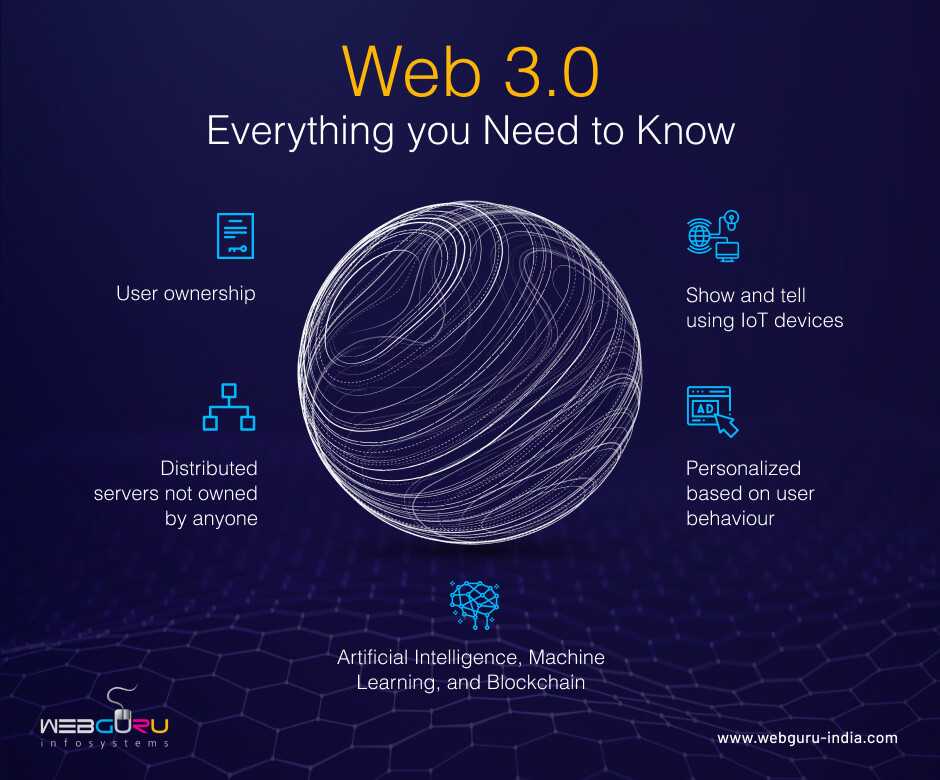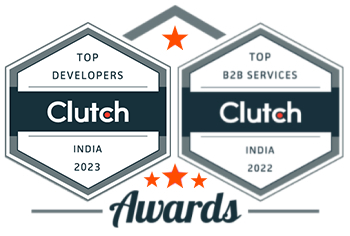Home Blog Website Development Web 3.0 – Everything you Need to Know
Web 3.0 – Everything you Need to Know
- 10 Jun / 2022
- 3,197 views

If you think yourself to be in a digital age where every activity of yours revolves around the internet, then think again. The real digital age with its full sweep shall unfold with the advent of Web 3.0. Here data will not be owned and controlled by a handful of big business conglomerates but by the users. Today, if users feel privacy, security, and trust issues surrounding data are the areas of concern, they can look to the future with hope.
In fact, Web 3.0 can be a welcome change for website design services that often grapple with security, privacy, and server issues. Yes, that is what Web 3.0 is likely to unleash for every service provider and/or user. It will make “real” and “virtual” complement each other in many ways. So, what is Web 3.0, and how it is likely to change the dynamics of the internet? Let us find out in the below-mentioned segment.
Web 3.0 – Transforming the Internet
Web 3.0 is the future of the internet. Here, technologies such as Artificial Intelligence, Machine Learning, and Blockchain will be harnessed to make faster, safe, and personalized communication and a superior UX. As a decentralized and open ecosystem with no regulating authority to speak of, Web 3.0 is likely to break the control of big entities and governments. It would give the control of data to the users. Also, it can transform the internet experience for users through the interfacing of smart homes, vehicles, and workplaces. However, to understand Web 3.0 better, it is important to know about Web 1.0 and Web 2.0.
What is Web 1.0?
This is the early phase of the internet dating from 1989 to 2004 where information on the World Wide Web was available as read-only. During this stage of the evolution of the internet, the websites were made from static web pages connected through hyperlinks. Here, as a user, you needed to know the URL of the website to access and seek information. Also, webmasters could create and manage pages only to allow the viewing of information by the users.
As search engines and servers improved over time, the average page load speed increased. Developers too implemented new techniques and technologies. This turned the internet into a more interactive and dynamic environment. Besides, it gave way to Web 2.0, the phase we are dealing with currently as you read this blog.
What is Web 2.0?
It is the second phase of internet evolution where users are able to read and write content. And it is driven by three key innovations – mobile, social media, and cloud. In this expanded digital sphere, people are not only able to consume information but even contribute through activities. These include blogging, podcasting, and interacting on social networking sites such as Twitter, Facebook, LinkedIn, YouTube, and others. This came about with the implementation of dynamic pages, frameworks, and advanced scripts. Popularized by Tim O Reilly and Dale Dougherty, the authors and founders of O’Reilly Media, the core competencies of any web development company representing Web 2.0 are:
Web 2.0 – Core Competencies
- Providing services with cost-effective and scalable solutions
- Controlling unique data sources that get enhanced in terms of quality and quantity as people use them more
- Offering attractive, lightweight, and easily navigable user interfaces and business models
- Allowing users to create, engage, and share information instead of merely consuming it
If in Web 2.0, users’ data is owned by big companies like Google, Facebook, Amazon, etc., Web 3.0 is going to be different. It will be a distributed and decentralized digital infrastructure. Here, AI-driven algorithms will analyze individual data and offer the internet as a personalized experience for each user. This can already be seen in platforms like Facebook, Youtube, Netflix, Amazon, etc. In these platforms, the personalized offerings are presented to the users based on their browsing patterns and behaviour. Interesting isn’t it, let us know more.
What is Web 3.0?
This will be the third phase of internet evolution where Artificial Intelligence, Machine Learning, Virtual Reality, Metaverse, and Blockchain technologies shall enable computers to interpret and understand the concept of data by themselves. The decentralized and distributed technology will take real-world communication to the next level and boost personalized user experience. Further, blockchain technology shall ensure secured user transactions and the dissemination of information.
If Web 1.0 was only about reading information on a website and Web 2.0 is about reading, writing, and sharing content in the form of text, images, or video on portals and mobile apps, Web 3.0 will be a game-changer. As an advanced version of the previous two phases, Web 3.0will allow users to interact with the real world but in a virtual iteration. Web 3.0 will be driven by IoT devices, 3D stores, and VR devices.
How are Web 1.0, 2.0, and 3.0 Different?
Interestingly, Web 3.0-based applications are going to be developed on peer-to-peer decentralized and distributed networks like IPFS and Ethereum. These networks will have the capability to self-organize without possessing a single point of failure. Now users depend on big corporations to access their personal data on the web. However, with Web 3.0, users can track their data on the web through distributed ledger technology. Let us understand the difference between the three phases for different parameters.
Parameter-based Analysis of the Three Phases
| Parameters | Web 1.0 | Web 2.0 | Web 3.0 |
| Content | Static | Dynamic, interactive, and user-generated – user data owned by big corporations | User ownership
Ex: Digital art and NFT |
| Technology | Basic HTML & CSS | Dynamic HTML, Java, JavaScript, and others | Artificial Intelligence, Machine Learning, and Blockchain |
| Virtual Environment | NA | 3D and Virtual Reality | Metaverse and Augmented Reality, and advanced VR |
| Advertisement | Static | Interactive | Personalized based on user behaviour |
| Storage | Individual web servers | Cloud storage owned by big corporations | Distributed servers not owned by anyone |
| Interactivity | Click or type | Touch, swipe, or voice | Show and tell using IoT devices |
| Information Type | Structured (SQL) | Unstructured (Big Data) | Distributed ledgers (Blockchain) |
How will Web 3.0 Function
The core technology to drive Web 3.0 will be Blockchain. It is the same technology used by Non Fungible Tokens and cryptocurrencies like Bitcoins. In Web 3.0, users do not have to create individual profiles for various platforms. Instead, a single profile will be enough to access any platform with the user having full ownership of content (personal or business related). Here, no one will be able to access users’ data and verify its accuracy without their permission. The ultimate goal of Web 3.0 is to create more open, connected, and intelligent websites. Additionally, you may read our blog on how to make your website successful and achieve business milestones.
Features of Web 3.0
The key features defining Web 3.0 will be:
Semantic Web
As a key element of Web 3.0, semantic web shall enable users to do a host of activities. These include creating, sharing, and tracking content, building vocabularies and setting up rules. The activities are for data handling based on the technology’s ability to interpret and understand the meaning of words rather than keywords. For better understanding, take the example of Google search engine, which offers search outcomes based on the contextual meaning of the search terms. So, if a user types “dog food”, the search results will list URLs showing “dog food and treats”, “dog food supplies”, and “pet food”, among others. Hence, semantic web will allow computers and algorithms to understand content in the same way as people do. This will lead to more relevant and quicker results. Also, it will utilize linked data to present contextual information to semantic queries. In other words, algorithms will become increasingly intelligent.
Openness
The architecture for Web 3.0 will be made by open-source software, which will be accessible to anyone. This means there will be no central regulating authority controlling data and information like the big corporations of today. Also, information will be spread across decentralized networks and distributed ledgers. Hence, a user can track his or her data and verify the code of the platform being used. Thus, there won’t be any trust issues like we have today where big tech companies control and manage all user data.
Ownership of Information
In Web 2.0, big companies like Amazon, Facebook, and others access our personal information (phone number, credit card numbers, interests, education, income, etc) and possibly sell them to the advertisers. However, in Web 3.0, the end users will own their information, which will be secured through encryption. The information can only be shared on a case-to-case basis only with users’ permission.
Less Number of Intermediaries
The decentralized form of Web 3.0 will connect service providers directly to the end customers. So, there won’t be any intermediary to take a share from an electronic transaction. For instance, if Amazon were to run on Web 3.0, then both sellers and buyers can get connected without Amazon dictating terms or imposing conditions. Web 3.0 does not envisage the elimination of all intermediaries and there is a need for regulation to ensure fairness.
Privacy
The growth in Web 2.0 is accompanied by the threats of cyber crime. There have been innumerable instances of information breaches making users wary of sharing their personal information online. Web 3.0 is expected to address this issue. This is because it will be based on blockchain technology where theft, alteration, or deletion of data will be next to impossible.
Uninterrupted Service
Today, users often face issues of server downtime, account suspension, or interrupted services. However, with the decentralized system of Web 3.0, data will be stored on distributed nodes having multiple backups. This will prevent the failure of single-point servers.
How Web 3.0-based Applications can Transform User Experience
Web 3.0 can transform user experiences, especially those related to user-oriented applications. Let us understand this with the following examples:
Social Media Networks
Social media has become a prominent aspect of Web 2.0 where users can interact freely and perform a host of activities. These include downloading or streaming video, images, chatting, etc. However, some big corporations owning user data have been found to be involved in activities that are not compliant with fairness and privacy. For instance, a particular platform had mined user data to find the latter’s political predilections. The information was later used (rather misused) to influence “thoughts”. Besides, such platforms having a monopoly on information distribution do not seem to follow standardized security protocols. However, with 3.0, there will be a push to create decentralized and secure social media networks using blockchain.
Exchange Services
It is secure to trade assets in a decentralized, open, and distributed digital infrastructure. Web 3.0 can enable a peer-to-peer exchange of assets, which will be easy to track, cost-efficient, and seamless.
Messaging
Data breach has become a serious threat with cybercriminals on the prowl to hack into individual user accounts. With Web 3.0’s encrypted messagging, tracking and hacking of individual user accounts by third parties will become redundant.
Steaming of Video and Music
Used for education, advertisement, and entertainment, the streaming platforms have the monopoly and can restrict users when they decide to leverage such platforms in a certain way – listening to music or viewing a video without any intervening advertisement. In Web 3.0, the decentralized streaming platforms shall provide an effective, secure, and transparent medium to users. Moreover, using smart contracts, these platforms can eliminate issues of copyright and plagiarism.
Conclusion
Web 3.0 will fundamentally change the way machines and humans communicate. It shall enable easy ownership transfers, cryptocurrency-based payments, and trustworthy data transfers. The decentralized applications of Web 3.0 hosted on user-operated blockchain nodes cannot be controlled or blocked by any central authority. By ushering in a user-centric, transparent, and open-source web infrastructure, Web 3.0 will focus more on privacy and security. Besides, it will create the possibilities of decentralized marketplaces, autonomous organizations, and self-sovereign identities. So, where does this leave full-stack website design services or others operating on digital platforms? The answer lies in their ability to foster enhanced security, greater interoperability, and better engagement with the open-source developers’ community.

Shrutarshi Das
Shrutarshi Das is a purveyor of all things digital, with a particular interest in new technological innovations, photography, and gaming.
2 comments
Leave a Reply

-
1000+
Happy
Clients -
25+
Countries
Served -
19+
Years of
Trust








Your mode of explaining everything in this article is truly pleasant.